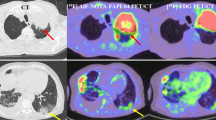Abstract
Objectives: For the histological diagnosis of small lung cancers of 10 mm or less in diameter (≤10), resection by video-assisted thoracic surgery (VATS) with computed tomography (CT)-guided marking is feasible. One problem is that a small number of these pulmonary nodules are malignant. We retrospectively analyzed CT images of pulmonary nodules to find better criteria to select candidates for resection among patients with small pulmonary nodules. Methods: Ninety-four patients with indeterminate peripheral pulmonary nodules underwent wedge resection by VATS. High-resolution CT using a 1.25 mm slice included the area of lesions. Nodules were classified by size (≤10, 11 to 22,>20 mm) and whether they had a ground-glass opacity (GGO) component. Results: The histology of all 94 nodules showed 52 primary lung cancers, 6 metastatic tumors, 5 benign tumors, 8 intrapulmonary lymph nodes, and 23 inflammatory nodules. Ninety-three percent of nodules larger than 20 mm, 75% of nodules 10 to 20 mm, and 43% of nodules ≤10 mm were malignant. Introducing a classification according to GGO component to nodules, malignancy was detected in 88% of nodules with a GGO component and in 30% of nodules without a GGO component among nodules ≤10 mm. Nodules ≤10 mm with a GGO component showed a statistically significant (p<0.01) correlation with malignancy. Conclusions: Pulmonary nodules ≤10 mm with GGO should be considered to have a high possibility of malignancy and to be candidates for resection by VATS.
Similar content being viewed by others
References
Fry WA, Menck HR, Winchester DP. The National Cancer Data Base report on lung cancer. Cancer 1996; 77: 1947–55.
Fontana RS, Sanderson DR, Taylor WF, Woolner LB, Miller WE, Muhm JR, et al. Early lung cancer detection: Results of the initial (prevalence) radiologic and cytologic screening in the Mayo Clinic study. Am Rev Respir Dis 1984; 130: 561–5.
Frost JK, Ball WC Jr, Levin ML, Tockman MS, Baker RR, Carter D, et al. Early lung cancer detection: results of the initial (prevalence) radiologic and cytologic screening in the Johns Hopkins study. Am Rev Respir Dis 1984; 130: 549–54.
Tsukada H, Kurita Y, Yokoyama A, Wakai S, Nakayama T, Sagawa M, et al. An evaluation of screening for lung cancer in Niigata Prefecture, Japan: A population-based case-control study. Br J Cancer 2001; 85: 1326–31.
Nishii K, Ueoka H, Kiura K, Kodani T, Tabata M, Shibayama T, et al. A case-control study of lung cancer screening in Okayama Prefecture, Japan. Lung Cancer 2001; 34: 325–32.
Martini N, Bains MS, Burt ME, Zakowski MF, McCormack P, Rusch VW, et al. Incidence of local recurrence and second primary tumors in resected stage I lung cancer. J Thorac Cardiovasc Surg 1995; 109: 120–9.
Li H, Boiselle PM, Shepard JO, Trotman-Dickenson B, McLoud TC. Diagnostic accuracy and safety of CT-guided percutaneous needle aspiration biopsy of the lung: Comparison of small and large pulmonary nodules. AJR Am J Roentgenol 1996; 167: 105–9.
Stringfield, JT, Markowitz DJ, Bentz RR, Welch MH, Weg JG. The effect of tumor size and location on diagnosis by fiberoptic bronchoscopy. Chest 1977; 72: 474–6.
Knight SB, Delbeke D, Stewart JR, Sandler MP. Evaluation of pulmolary lesions with FDG-PET. Comparison of findings in patients with and without a history of prior malignancy. Chest 1996; 109: 982–8.
Yoon, H, Yana T, Iwase K, Higaki J, Takada M, Kamiike W. Resection of pulmonary nodules equal or less than 10mm in diameter by video-assisted thoracic surgery with CT-guided hook wire technique. Eur J Cancer 2001; 37: 47.
Henschke CI, McCauley DI, Yankelevitz DF, Naidich DP, McGuinness G, Miettinen OS, et al. Early Lung Cancer Action Project: Overall design and findings from baseline screening. Lancet 1999; 354: 99–105.
Kaneko, M, Eguchi K, Ohmatsu H, Kakinuma R, Naruke T, Suemasu K, et al. Peripheral lung cancer: Screening and detection with low-dose spiral CT versus radiography. Radiology 1996; 201: 798–802.
Ayabe H, Tsuji H, Nakamura A, Takahashi T, Matsuo S, Akamine S, et al. Evaluation of hilar and mediastinal lymph node metastases in resected cases of bronchogenic carcinoma (Eng abstr). Kyobu Geka 1994; 47: 28–32.
Kawano R, Yokota T, Ikeda S, Sakaguchi H, Hata E. Analysis of nodal involvement in small peripheral lung carcinoma less than 2.0 cm in diameter. Jpn J Chest Surg 2003; 17: 3–7.
Watanabe Y, Hayashi Y, Takabatake I, Shimizu J, Murakami S, Morita K, et al. Clinical significance of extended mediastinal lymph node dissection on the basis of clinicopathological analysis of nodal involvement in bronchogenic carcinoma (Eng abstr). Kyobu Geka 1994; 47: 4–9.
Shure D, Fedullo PF. Transbronchial needle aspiration of peripheral masses. Am Rev Respir Dis 1983; 128: 1090–2.
Hasegawa M, Sone S, Takashima S, Li F, Yang ZG, Maruyama Y, et al. Growth rate of small lung cancers detected on mass CT screening. Br J Radiol 2000; 73: 1252–9.
Nakata M, Sawada S, Saeki H, Takashima S, Mogami H, Teramoto N, et al. Prospective study of thoracoscopic limited resection for ground-glass opacity selected by computed tomography. Ann Thorac Surg 2003; 75: 1601–6.
Swanson S, Iaklitsch M, Mentzer S. The probability of malignancy in solitary pulmonary nodules: application to small radiologically indeterminate nodules. Arch Intern Med 1997; 57: 849–55.
Henschke CI, Yankelevitz DF, Mateescu I, Brettle DW, Rainey TG, Weingard FS. Neural networks for the analysis of small pulmonary nodules. Clin Imaging 1997; 21: 390–9.
Author information
Authors and Affiliations
Rights and permissions
About this article
Cite this article
Yoon, HE., Fukuhara, K., Michiura, T. et al. Pulmonary nodules 10 mm or less in diameter with ground-glass opacity component detected by high-resolution computed tomography have a high possibility of malignancy. Jpn J Thorac Caridovasc Surg 53, 22–28 (2005). https://doi.org/10.1007/s11748-005-1004-8
Received:
Accepted:
Issue Date:
DOI: https://doi.org/10.1007/s11748-005-1004-8




